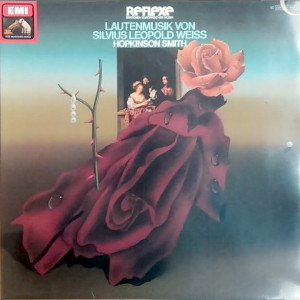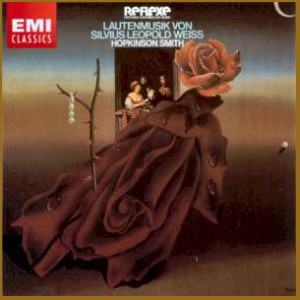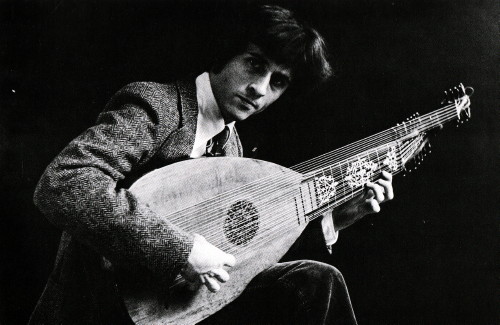 |
1 LP -
1C 065-30 944 Q - (p) 1978
|

|
| 1 CD - 8
26513 2 - (c) 2000 |
|
| LAUTENMUSIK
VON SILVIUS LEOPOLD WEISS (1686-1750) |
|
|
|
|
|
| Suite d-moll |
|
|
| - Prélude |
1' 22" |
|
| - Allemande |
3' 22" |
|
| - Courante |
1' 41" |
|
| -
Menuets I und II |
2' 30" |
|
| -
Bourrée |
1'
45"
|
|
| - Sarabande |
2' 19" |
|
| -
Gigue |
1' 48" |
|
| Tombeau
sur la Mort de M. Conte de Logy
arrivée 1721 |
8' 53" |
|
|
|
|
| Prélude und
Fantasie c-moll |
4' 40" |
|
| Suite D-dur |
|
|
| -
Prélude |
1' 50" |
|
| - Aria |
5' 05" |
|
| -
Courante |
3' 17" |
|
| -
Sarabande |
4' 27" |
|
| -
Passagaille |
4' 05" |
|
| -
Gigue |
2' 57" |
|
|
|
|
Hopkinson Smith, Theorbe
(Laute) von Leopold Widhalm, Nürnberg
1755
|
|
|
|
|
|
Luogo
e data di registrazione |
|
Séon
(Svizzera) - novembre 1977 |
|
|
Registrazione: live /
studio |
|
studio |
|
|
Producer / Engineer |
|
Gerd
Berg / Johann-Nikolaus Matthes
|
|
|
Prima Edizione LP |
|
EMI
Electrola "Reflexe" - 1C 065-30
944 Q - (1 lp) - durata 50' 01" -
(p) 1978 - Analogico
(Quadraphonic) |
|
|
Prima Edizione CD |
|
EMI
"Classics" - 8 26513 2 - (1 cd) -
durata 50' 01" - (c) 2000 - ADD |
|
|
Note |
|
- |
|
|
|
|
|
 Silvius
Leopold Veiß (1686-1750) is
without question the most
important lutenist of the
German baroque and one of the
greatest of all time. His
historical significance would
be firmly established by
virtue of his enormous output
alone, for he left over
seventy sonatas
(suites) in tablature, by far
the largest corpus of music
for solo lute of any composer
in the history of the
instrument. However, the
quantity of these sonatas is
matched by their quality. In 1782
Bach’s biographer Forkel
praised the “excellent and
difficult compositions” of
Weiß, “which are written in
the pure and pithy style, much
like the harpsichord works of
the late J. S. Bach.” Born in
Breslau, weiß
learned to play the
lute as a boy from his father
Johann Jakob, as did Silvius’
younger brother Johann
Sigismund. Virtually nothing
is known about the weiß family
until the two young lutenists
were engaged at the Palatinate
court in Düsseldorf
in 1706. Two years later
Silvius accompanied the Polish
Prince Alexander Sobiesky to Italy,
where the two remained until
the Prince’s death in 1714.
This Italian
sojourn had a profound impact
on Weiß's
musical style, since the music
he composed afterwards show a
strong influence of Italian
concerto elements. ln 1717
Weiß appeared at the court of
August the Strong, King of
Poland and Elector of Saxony
in Dresden. A year later he
was permanently attached to
the Dresden Hofcapelle, and
kept the position of court
lutenist there for the rest of
his life. By 1744 he was the
highest-paid instrumentalist
in the Hofcapelle, a measure
of the esteem in which he was
held by his sovereign. Weiß’s
fame was not restricted to the
Dresden court, however. As
early as 1713 the prominent
Hamburg critic and composer
Johann Mattheson
described Weiß
as "a
perfect musician," and in 1728
as “the greatest lutenist in
the world,” though Weiß was
known to him almost
exclusively by reputation. In his
Study of the Lute
(1727), Ernst Gottlieb Baron
raves for two pages about
Weiß's accomplishments: “I can
sincerely testify that it
makes no difference whether
one hears an ingenious
organist performing his
fantasias and fugues on a
harpsichord or hears Monsieur
Weiß playing.” This great
skill and renown drew lute
students to Dresden from all
over Germany and from as far
away as Russia. Through this
personal contact and through
the wide circulation of his
pieces in manuscript, Weiß’s
influence on the younger
generation of lutenists was
considerable. Silvius
Leopold Veiß (1686-1750) is
without question the most
important lutenist of the
German baroque and one of the
greatest of all time. His
historical significance would
be firmly established by
virtue of his enormous output
alone, for he left over
seventy sonatas
(suites) in tablature, by far
the largest corpus of music
for solo lute of any composer
in the history of the
instrument. However, the
quantity of these sonatas is
matched by their quality. In 1782
Bach’s biographer Forkel
praised the “excellent and
difficult compositions” of
Weiß, “which are written in
the pure and pithy style, much
like the harpsichord works of
the late J. S. Bach.” Born in
Breslau, weiß
learned to play the
lute as a boy from his father
Johann Jakob, as did Silvius’
younger brother Johann
Sigismund. Virtually nothing
is known about the weiß family
until the two young lutenists
were engaged at the Palatinate
court in Düsseldorf
in 1706. Two years later
Silvius accompanied the Polish
Prince Alexander Sobiesky to Italy,
where the two remained until
the Prince’s death in 1714.
This Italian
sojourn had a profound impact
on Weiß's
musical style, since the music
he composed afterwards show a
strong influence of Italian
concerto elements. ln 1717
Weiß appeared at the court of
August the Strong, King of
Poland and Elector of Saxony
in Dresden. A year later he
was permanently attached to
the Dresden Hofcapelle, and
kept the position of court
lutenist there for the rest of
his life. By 1744 he was the
highest-paid instrumentalist
in the Hofcapelle, a measure
of the esteem in which he was
held by his sovereign. Weiß’s
fame was not restricted to the
Dresden court, however. As
early as 1713 the prominent
Hamburg critic and composer
Johann Mattheson
described Weiß
as "a
perfect musician," and in 1728
as “the greatest lutenist in
the world,” though Weiß was
known to him almost
exclusively by reputation. In his
Study of the Lute
(1727), Ernst Gottlieb Baron
raves for two pages about
Weiß's accomplishments: “I can
sincerely testify that it
makes no difference whether
one hears an ingenious
organist performing his
fantasias and fugues on a
harpsichord or hears Monsieur
Weiß playing.” This great
skill and renown drew lute
students to Dresden from all
over Germany and from as far
away as Russia. Through this
personal contact and through
the wide circulation of his
pieces in manuscript, Weiß’s
influence on the younger
generation of lutenists was
considerable.
Yet despite this fame, little
information survives todaz about
his appearance, his
familz, or his personal
affairs. The onlz likeness of
him, the engraving reproduced
here, was made in the
eighteenth century after a
contemporary painting by the
great portraitist Balthasar
Denner. The painting, now
lost, was probably executed in
about 1730. In
approximately 1720 Weiß married,
and had seven children by his
death in 1750; at least two of
them were talented musicians.
Though he was well paid, he
apparently lived rather too
well, since his family was
destitute after his death. Of
his personality, one old
anecdote is perhaps
characteristic: “In the
fiftieth year of his life
(1736) the great lutenist Weiß answered
the question of how long he
had been playing the lute with
"twenty
years".
One of his friends, who knew
for certain that Weiß already
was playing the lute in his
tenth year, wanted to
contradict him, but he
interrupted and said, "True,
but for twenty years I was
tuning."
Weiß's
musical style is, like that of
Bach, a German synthesis of
the French and Italian
baroque styles. Weiß was
doubtless familiar with suites
by the great French baroque
lutenists Gaultier, Gallot, Mouton,
and so forth, and with the
modified French music composed
during the late 17th century
by the German lutenists Esaias
Reusner,
Jakob Büttner,
and Philip Franz LeSage de Richée.
From them, and perhaps more
directly from Count Losy, Weiß
adopted the dance suite. In
Italy, and doubtless also
through the influence of the
Italian musicians at the
Dresden court, Weiß refined
his style, adopting cantabile
elements, increasing the force
of harmonic propulsion, and
extending the length of most
sonata movements. The result
is an individual style that
nonetheless sounds much like
Bach’s, although the two
greatest masters of their
respective instruments
probably did not meet
personally betore
1720 (one documented meeting
at Bach’s house in Leipzig
took place in 1739) and had
little apparent influence on
each other.
Most of
Weiß’s music is arranged in
the form of dance suites,
which in his manuscripts are
always referred to as Suonaten
or Partien. The order of
movements in the sonatas is
typically the following:
prelude (optional), allemande,
courante, bourrée,
sarabande, minuet,
gigue or allegro, but
substitutions for one or more
of the movements occur
frequently. Some pieces - two
tombeaux, a variety of
fantasias, and so forth -
appear to have been conceived
independently of the sonata. A
few four-movement sonatas for
lute and bowed strings also
survive, but unfortunately all
are missing the string parts.
Weiß’s career can be divided
into three major periods of
activity, with respect to the
development of his style.
The early period extends to
about 1715, when he returned
to Germany from Italy. The
middle period documents his
activity during his first
years in Dresden, until about
1725, and is characterized by
strong influx of the
Italianate elements enumerated
above. Approximately fifteen sonatas
survive from the last twenty-five
years of Weilß’s life, and in
them he continued to refine
the style of his middle
period. The music on the
present recording is
representative of the best
works of the middle period.
The Sonata in D minor
was
probably composed in Dresden
in the early 1720’s,
perhaps partly for pedagogical
reasons, since a note in a
student`s hand of Weiß’s
autograph manuscript
indicates: “This was the first
partita I
learned with Monsieur Weiß".
The prelude is unbarred but
falls neatly into phrases in
common time. The running
sixteenth-note figurations
essentially constitute a long
sequence of broken chords, not
unlike the first prelude in Bach’s
Well-Tempered
Clavier.
In
the allemande, by contrast,
the emphasis is less on
harmony than on the
languishing melody; this piece
is really an aria for lute.
The courante and bourrée are
again more instrumental in
character, both vigorous
dances designed to provide
momentum between the more
solemn allemande and
sarabande. The two minuets,
here played as a single minuet
en rondeau, are quick,
lighthearted movements, the
sarabrindc contemplative, and
the gigue a rollicking
finale.
One of the most hauntingly
beautiful pieces in the entire
history of lute music is the Tombeau
on the Death of Count Losy.
Count Jan Antonín Losy
von Losinthal (1650-1721) was
a landed Bohemian aristocrat
of Austrian heritage, an Imperial
Court Chamberlain, and the
most highly respected German
baroque lutenist before Weiß,
Weiß had undoubtedly met Losy
personally in Vienna or
Prague, and may have studied
with him for a time in his
youth.
As a tribute to Losy upon his
death, Weiß conceived
a piece in the key of B-flat
minor, an unusual and
difficult key
on the lute because of the
many barres it necessitates at
the first fret. The wistful
character of this tombeau is
established by means of
frequent diminished seventh
chords and other dissonances,
and by the slow pace. A
particularly elegiac effect is
created by the bass pedal
point at the verybeginning and
by other repeated notes, which
are obviously intended to
suggest the tolling of funeral
bells.
The C minor prelude on
this recording is one of
Weiß’s boldest experiments in
shocking harmonies and
chromaticism. It
seems to have been composed
about 1720, although in style
it more resembles music
written nearly a half-century
later. The autograph
manuscript of this prelude,
from which Hopkinson Smith
plays, is sketched out
rapidly, which implies that it
may represent an improvisatory
composition. This impression
of improvisation is supported
by the predominance of very
free, irregular rhythms
reminiscent of the
17th-century French unmeasured
prelude. Weiß here
makes unusually extensive use
of the diminished seventh
chord, an ambiguous harmony,
and includes a long passage
based upon a cleverly
disguised chromatically
descending octave in the bass.
The mood created by these
devices is unsettling, almost
schizophrenic, and is very
atypical for Weiß and late
baroque music in general. By
contrast, the Fantasie in
C minor that follows is
much more conventional in
conception. The first half
consists of even, arpeggiated
figurations in the manner of a
prelude, and the second half
of a fugato with a long,
sequential episode between the
entries of the theme.
The present Sonata in D
major is comprised of
various movements from the
Weiß manuscript in the British
Library. The prelude, like the
others on this recording, is
unbarred, with passages of
running arpeggios alternating
with block chords over a pedal
point. The Aria is another
allemande with strongly vocal
characteristics, its long,
spunout melody full of pathos
and frequent sigh figures. The
courante is like a movement
from a Vivaldi concerto in its
rapid figurations and
relentless forward propulsion.
Like the allemandes on this
recording, the D major
sarabande is operatic in
inspiration, with pathetic
sigh figures and a few
virtuoso flourishes. The
passagaille (passacaglia)
consists of a theme and eleven
variations, of which the last
is a slightly more ornate
version of the theme. The bass
remains the same in all
variations, but the melody is
transformed by elaborate
embellishments. A particularly
ingenious feature of this
passacaglia is the length of
the theme - an uneven seven
measures; the first measure of
each successive variation is
at the same time the last
measure of the preceding one,
thereby filling it out to a
total of eight. A lively gigue
provides an appropriate
finale.
Douglas
Alton Smith
The Widhalm lute is similar to
an aged aristocratic
general, the hero of battles
long since fought, still with an
elegant and proud bearing, but
also, no longer the tactician
he once was. The strengths of
the instrument - apart from
the amazing phenomenon that it
has survived in playing
condition without restoration
- lie in its wonderfully rich
bsss
register and in the clear
singing quality of the upper
strings (the first five
courses were strung in gut for
this recording). Less strong
qualities include a middle
register with less power than
it probably had originally and
also a mild stubbornness on
the part of the instrument in
lighter movements whose agile
passagework could have been
more clearly realized on a
more flexible modern
instrument.
The decision on my part to use
an original instrument does
not come from
any self-righteous assertion
that the music of a
particular period is
“supposed” to sound in one
specific way and that we
must therefore adhere to
burdensome “rules” of a time
and style. It
comes rather from, first of
all, a natural curiosity to
see what old instruments are
like - so few are in
playable condition and they
can normally be borrowed
only for a specific project
- and secondly, the desire
to see just how this
instrument and this music
would adapt to each other.
This project remains as much
a document of a magnificent
18th century lute (the first
to be recorded, I believe)
as it is a testament to the
greatest 18th century
Iutenist composer.
Three notes on the
programming:
1) In the Dresden Weiß Manuscript
version of the D minor
Suite, what is here
played as a minuet en
rondeau is copied out
as two distinct Minuets
separated by the Sarabande.
I have chosen rather to make
one more substantial piece
out of the two and to build
n more dramatic pacing into
the suite by pairing the
Sarabande with the Gigue.
2) The Prélude
and Fantasy in
C minor are also
separated in the British
Museum Weiß
Ms from
which they come,
but are here combined. Out
of the turmoil of harmonic
instability of the Prélude,
enters the unmeasured but
more stable opening of an
old friend, the C minor
Fantasie, one of the
best known lute pieces of
Weiß.
3) The last suite is a
regrouping of some of the
best pieces in D major from
different parts of the
British Museum Ms. Despite
their dispersion in the
manuscript, there are
thematic similarities
between the movements
(especially the Aria
and Sarabande), and
they fit together into a
well proportioned suite.
Hopkinson
Smith
|
|
|
EMI Electrola
"Reflexe"
|
|
|
|

